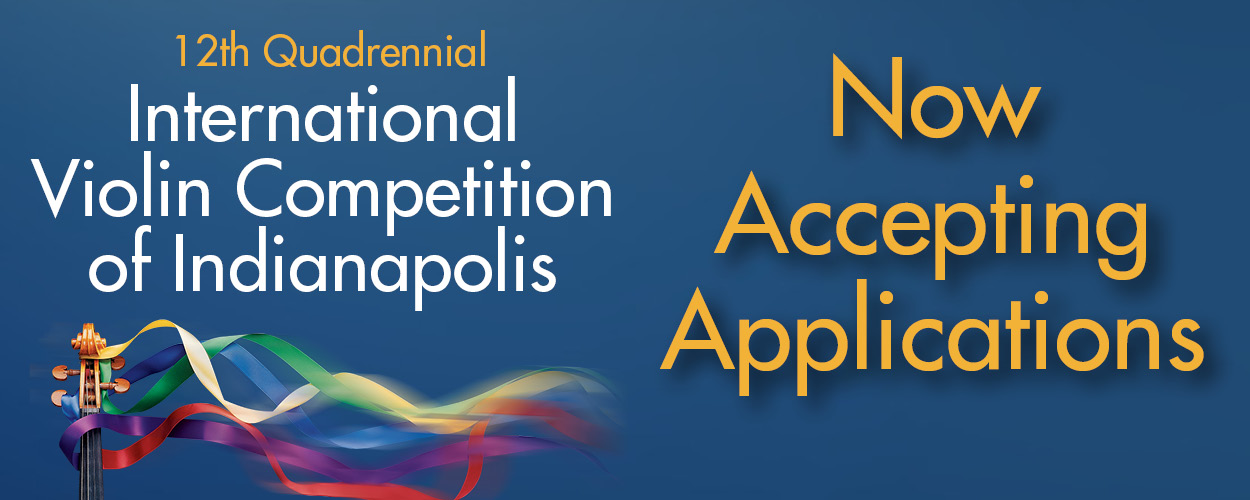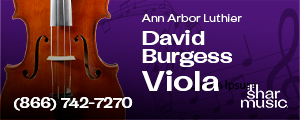December 2013
Claire and Adam's Violin Lessons, Blog 2: Squeezing sponge
December 28, 2013 12:08EDITOR'S NOTE: Violin teacher Adam DeGraff and adult violin student Claire Silvester are sharing their thoughts from their Skype lessons together in this series of blogs. Here are links to other blogs in the series: Blog 1: Claire's introduction: Approaching New Year - reflecting and resolutions. and Blog 3: Squeezing Sponge Reply by Adam
I take lessons every two weeks, it’s currently the ‘in-between week’ and I’m working on a particular bowing pattern/feel/interpretation/skill in the gigue I’m learning. This feels like backwards Bach, I love it (I’m enjoying turning former conditioned phrasing on its head) but it’s the direct opposite of the motion my right arm instinctively insists on executing. It is a pattern of three slurred semiquavers (16th notes) followed by three detache semiquavers, repeat.
Adam’s instruction for this pattern goes something like this; I need to start at the heel and create an intensifying/crescendo/denseness that travels throughout the slur right up until moment of bow change (which I do technically by dropping weight into my bow, moving my sound point closer to the bridge and reducing bow speed) rebounding light into the detache bows, which are performed in a zig-zag motion returning towards the heel for the next slur. Each pattern loop moves a short distance further towards the middle of the bow until the end of the phrase.
Okay :) I genuinely intellectually comprehend that.
Adam metaphorically described this as if having hold of a sponge and squeezing it increasingly tighter and then allowing it to release to original shape (concentrating on the densest/release transition)
Okay :) I can genuinely imagine that image whilst playing the phrase in my mind and I hear it work musically.
So why can’t I do it on the violin?
I don’t have an abundance of actual time to practice, but I’m finding I think about it a lot every available moment, proper contemplative thinking about how to maximise my experience. I particularly like deconstructing and theorising using a neurodevelopmental approach. Especially during the dead areas of day taken up by walking to work or similar…
Back to the point! So why can’t I do it on the violin!
I’ve considered this; it starts with a premise from Montessori education – we are sensorial beings, our very first route of learning is entirely through our senses. Montessori is a proponent of rooting early education in the concrete and not in the abstract. The violin is a multi-sensorial instrument.
When Adam is instructing, for him it is already concrete, he can physically execute the bowing, he knows how it feels, he can describe a metaphor to further clarify the sensation, he knows how that feels and that it is a metaphoric match.
Even though I comprehend the description, for me, this is all abstract. I cannot execute the bowing, I do not know how it feels. I can squeeze an actual sponge for a concrete sensory starting point though. This is also easier than the bowing…
Making things concrete deepens my ability to translate sensations. So I've been working in the concrete like this; play the phrase in my mind whilst applying the dense/release pattern appropriately rhythmically to a sponge ball. The real world tactile feedback of this is actually quite cool. Because I've actually felt it with my hands, in conjunction with the music - it’s become an easier thought to reference when practicing on the violin. Now practicing focused repetitions in the abstract is making much more sense, because it's just not quite so abstract...
Tweet
Claire and Adam's Violin Lessons, Blog 1: Approaching New Year - reflecting and resolutions.
December 28, 2013 12:00EDITOR'S NOTE: Violin teacher Adam DeGraff and adult violin student Claire Silvester are sharing their thoughts from their Skype lessons together in this series of blogs. Here are links to other blogs in the series: Blog 2: Claire's question: Squeezing the Sponge and Blog 3: Squeezing the Sponge Reply by Adam
My Self from twelve months past would have considered blogging as one of the most unlikely pursuits to be taking into 2014, yet here I am…
I feel like some background information would be helpful;
I’m an adult violin student. I resumed study this year following a seventeen year hiatus.
I have fairly substantial training from before. As a child I was devoted to my study and I have the pre-requisite stripes expected in youth… I truly love the violin; it is the voice of my soul. When I quit after secondary school I’d come to a place in my training where I was actually unable to play, I’d become deeply confused, uncomfortable and frustrated; interacting with my instrument was emotionally painful.
Professionally I’m trained in multiple disciplines including Neurodevelopmental Therapy, Play-Based Social Interaction therapies, Auditory Integration Therapy and Montessori Education. I’m fascinated by the brain, alternative education, creative practice, efficient learning; I love it all.
I work for an amazing youth charity as Creator/Director of a music project for disadvantaged 8 -18 year olds, many of whom have had no prior access to music. We recently celebrated our first winter performance, I'm incredibly proud of and inspired by my youth group. Teaching and studying simultaneously is just excellent in every possible way.
I’m a holistic practitioner - it excites me to connect all aspects of my study, I’m really enjoying approaching my practice creatively by incorporating therapeutic disciplines or experiences from youth work to see what happens next. It feels so much more fluid to work this way, I feel deeply motivated to learn.
This is one component of an interconnected blog - Student Perspective. I’m incredibly grateful to be learning with a teacher that directs, inspires and actively encourages experimentation and progressive learning approaches; my teacher is Adam DeGraff.
I’m in the U.K and Adam’s in the U.S so lessons take place on Skype, our entire communication takes place on the internet. I’ve never had a teacher I haven’t actually met in person before, which was a bit weird initially. Skype-class has some advantages not found in traditional lessons; first and foremost - I am able to access precisely the tuition I want, studying with the teacher I want, I have the ability to be completely warmed up even to the moment immediately prior to my lesson, learning in my own practice room is awesome and ultimately comfortable, I have the ability to practice concepts from directly the moment after my lesson ends, I’m not uncomfortable from having to travel for tuition, or rushed because of delay in travel and the money I save in travel costs I can channel straight into more lessons. I like these aspects immensely. Adam is really very specific with his instruction; I don’t believe quality is lost by learning this way.
There are some things I miss from learning in-person, tactile cues are useful, also a really good bit about violin teachers is that they have an awesome sounding violin – I don’t quite get to appreciate this fully through laptop speakers, but these are small things and not ultimately relevant.
I’m fairly early on in resuming my study and truly exciting things are happening, Adam creates an open environment of collaboration when he’s teaching - and this, for me is fundamentally important. I’m encouraged to feedback on my practice in-between lessons, and slowly this is sparking a spontaneous shared exchange of concepts, spinning my brain into deeper thought about music and playing than ever before, and it’s really fun. And sometimes it’s really emotional. First steps from constriction to freedom. It is 100% authentic.
Freedom and sharing have been prominent themes in lessons so far. This blog represents both.
The idea is I’ll share my learning, and Adam will share his teaching, and together we’ll journal a reflective/interactive discussion here where others can share in it too.
Tweet
Violinist.com is made possible by...
Violinist.com Holiday Gift Guide
Dimitri Musafia, Master Maker of Violin and Viola Cases
International Violin Competition of Indianapolis
Johnson String Instrument/Carriage House Violins
Subscribe
Laurie's Books
Discover the best of Violinist.com in these collections of editor Laurie Niles' exclusive interviews.

Violinist.com Interviews Volume 1, with introduction by Hilary Hahn

Violinist.com Interviews Volume 2, with introduction by Rachel Barton Pine






